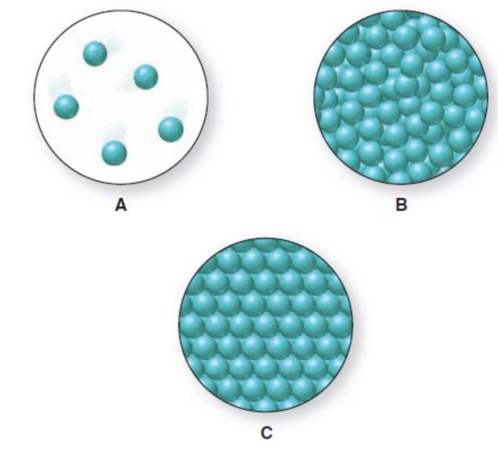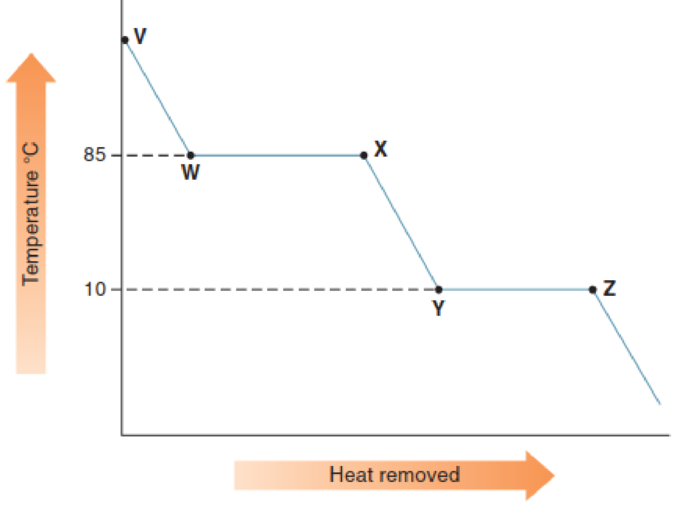
Connect 1-Semester Online Access for Principles of General, Organic & Biochemistry
2nd Edition
ISBN: 9780077633707
Author: Janice Smith
Publisher: Mcgraw-hill Higher Education (us)
expand_more
expand_more
format_list_bulleted
Concept explainers
Textbook Question
Chapter 4, Problem 4.32UKC
Which line segments on the cooling curve in Problem 4.31 correspond to each of the following physical states?


Expert Solution & Answer
Want to see the full answer?
Check out a sample textbook solution
Students have asked these similar questions
As a substance is subjected to pressure and/or temperature changes, it may undergo condensation, deposition, freezing, melting, sublimation, or vaporization. (a) Consider the phase diagram shown below and state the cha nges that take place upon going from points A to B to C to D. (b) Is the transition from C to D exothermic or endothermic?
41.
(a) A person drinks four glasses of cold water (3.0°C) every day. The volume of each glass is2.6×102mL. How much heat (in kJ) does the body have to supply to raise the temperature of the water to 37°C, the body temperature?
(b) How much heat would your body lose if you were to ingest7.0×102g of snow at 0°C to quench your thirst? (The amount of heat necessary to melt snow is 6.01 kJ/mol.)
A 337.2 g sample of acetone gas with a temperature of 56.0°C is converted to a liquid with a temperature of 56.0°C. How much heat is involved?
Chapter 4 Solutions
Connect 1-Semester Online Access for Principles of General, Organic & Biochemistry
Ch. 4.1 - Prob. 4.1PCh. 4.1 - Prob. 4.2PCh. 4.1 - Prob. 4.3PCh. 4.1 - Prob. 4.4PCh. 4.2 - Prob. 4.5PCh. 4.2 - Prob. 4.6PCh. 4.3 - Prob. 4.7PCh. 4.3 - Prob. 4.8PCh. 4.3 - Prob. 4.9PCh. 4.3 - Prob. 4.10P
Ch. 4.3 - Which of the compounds in each pair has stronger...Ch. 4.4 - Prob. 4.12PCh. 4.4 - Prob. 4.13PCh. 4.5 - A student has two containers one with 10 g of...Ch. 4.5 - Prob. 4.15PCh. 4.5 - How much energy is required to heat 28.0 g of iron...Ch. 4.5 - Prob. 4.17PCh. 4.5 - Prob. 4.18PCh. 4.5 - Prob. 4.19PCh. 4.6 - Prob. 4.20PCh. 4.6 - Prob. 4.21PCh. 4.6 - Label each process as endothermic or exothermic...Ch. 4.6 - Prob. 4.23PCh. 4.7 - Answer the following questions about the graph. a....Ch. 4.7 - Prob. 4.25PCh. 4.7 - If the cooling curve in Figure 4.5 represented a...Ch. 4.7 - How much energy (in calories) is released when...Ch. 4.7 - Prob. 4.28PCh. 4 - What phase change is shown in the accompanying...Ch. 4 - What phase change is shown in the accompanying...Ch. 4 - Consider the cooling curve drawn below. a. Which...Ch. 4 - Which line segments on the cooling curve in...Ch. 4 - Prob. 4.33UKCCh. 4 - Prob. 4.34UKCCh. 4 - Prob. 4.35UKCCh. 4 - Prob. 4.36UKCCh. 4 - Prob. 4.37UKCCh. 4 - Prob. 4.38UKCCh. 4 - Prob. 4.39APCh. 4 - Prob. 4.40APCh. 4 - Prob. 4.41APCh. 4 - Prob. 4.49APCh. 4 - Prob. 4.50APCh. 4 - Prob. 4.54APCh. 4 - Prob. 4.55APCh. 4 - Prob. 4.56APCh. 4 - Prob. 4.57APCh. 4 - Prob. 4.58APCh. 4 - Prob. 4.59APCh. 4 - Prob. 4.60APCh. 4 - Prob. 4.61APCh. 4 - Prob. 4.62APCh. 4 - Prob. 4.63APCh. 4 - Prob. 4.64APCh. 4 - Prob. 4.65APCh. 4 - Prob. 4.66APCh. 4 - Prob. 4.67APCh. 4 - Prob. 4.68APCh. 4 - Prob. 4.69APCh. 4 - Prob. 4.70APCh. 4 - Prob. 4.71APCh. 4 - Prob. 4.72APCh. 4 - Prob. 4.73APCh. 4 - Prob. 4.74APCh. 4 - Prob. 4.75APCh. 4 - Prob. 4.76APCh. 4 - Prob. 4.77APCh. 4 - Prob. 4.78APCh. 4 - Prob. 4.79APCh. 4 - Why does steam form when hot lava falls into the...Ch. 4 - Prob. 4.81APCh. 4 - Prob. 4.82AP
Knowledge Booster
Learn more about
Need a deep-dive on the concept behind this application? Look no further. Learn more about this topic, chemistry and related others by exploring similar questions and additional content below.Similar questions
- If 14.5 kJ of heat were added to 485 g of liquid water, how much would its temperature increase?arrow_forwardHow much heat, in joules and in calories, is required to heat a 28.4-g (1-oz) ice cube from 23.0 C to 1.0 C?arrow_forwardYou heat 1.000 quart of water from 25.0C to its normal boiling point by burning a quantity of methane gas, CH4. What volume of methane at 23.0C and 745 mmHg would you require to heat this quantity of water, assuming that the methane is completely burned? The products are liquid water and gaseous carbon dioxide.arrow_forward
- How many grams of water at 0C will be melted by the condensation of 1 g of steam at 100C?arrow_forwardEqual masses of liquid A, initially at 100C, and liquid B, initially at 50C, are combined in an insulated container. The final temperature of the mixture is 80C. All the heat flow occurs between the two liquids. The two liquids do not react with each other. Is the specific heat of liquid A larger than, equal to, or smaller than the specific heat of liquid B?arrow_forwardHow much heat, in joules and in calories, must be added to a 75.0g iron block with a specific heat of 0.449 Jig C to increase its temperature from 25 C to its melting temperature of 1535 C?arrow_forward
- A burning match and a bonfire may have the same temperature, yet you would not sit around a burning match on a fall evening to stay warm. Why not?arrow_forward5-81 Compare the number of calories absorbed when 100. g of ice at 0°C is changed to liquid water at 37°C with the number of calories absorbed when 100. g of liquid water is warmed from 0°C to 37°C.arrow_forwardDetermine the amount of heat released when 497 g of Pb are cooled from 37.2 °C to 22.5 °C and the specific heat of Pb is 0.129 J/g °C.arrow_forward
- What mass in grams of liquid substance X can be increased in temperature from 25.70C to 100.00C with the addition of 1187 calories of heat? (The specific heat capacity of substance X is 0.412 cal/g0C.)arrow_forwardA student was comparing two 21.0g of solid metals to 80°C and after adding it to identical beakers of water. The student notices that in the second metal there was a larger change in temperature. What can we conclude about the second piece of metal?arrow_forwardHow many joules of energy are released when 45.0 g of water cools from 18.0 ºC to 7.0 ºC?arrow_forward
arrow_back_ios
SEE MORE QUESTIONS
arrow_forward_ios
Recommended textbooks for you
 Physical ChemistryChemistryISBN:9781133958437Author:Ball, David W. (david Warren), BAER, TomasPublisher:Wadsworth Cengage Learning,
Physical ChemistryChemistryISBN:9781133958437Author:Ball, David W. (david Warren), BAER, TomasPublisher:Wadsworth Cengage Learning, Chemistry by OpenStax (2015-05-04)ChemistryISBN:9781938168390Author:Klaus Theopold, Richard H Langley, Paul Flowers, William R. Robinson, Mark BlaserPublisher:OpenStax
Chemistry by OpenStax (2015-05-04)ChemistryISBN:9781938168390Author:Klaus Theopold, Richard H Langley, Paul Flowers, William R. Robinson, Mark BlaserPublisher:OpenStax Introduction to General, Organic and BiochemistryChemistryISBN:9781285869759Author:Frederick A. Bettelheim, William H. Brown, Mary K. Campbell, Shawn O. Farrell, Omar TorresPublisher:Cengage Learning
Introduction to General, Organic and BiochemistryChemistryISBN:9781285869759Author:Frederick A. Bettelheim, William H. Brown, Mary K. Campbell, Shawn O. Farrell, Omar TorresPublisher:Cengage Learning General Chemistry - Standalone book (MindTap Cour...ChemistryISBN:9781305580343Author:Steven D. Gammon, Ebbing, Darrell Ebbing, Steven D., Darrell; Gammon, Darrell Ebbing; Steven D. Gammon, Darrell D.; Gammon, Ebbing; Steven D. Gammon; DarrellPublisher:Cengage Learning
General Chemistry - Standalone book (MindTap Cour...ChemistryISBN:9781305580343Author:Steven D. Gammon, Ebbing, Darrell Ebbing, Steven D., Darrell; Gammon, Darrell Ebbing; Steven D. Gammon, Darrell D.; Gammon, Ebbing; Steven D. Gammon; DarrellPublisher:Cengage Learning World of Chemistry, 3rd editionChemistryISBN:9781133109655Author:Steven S. Zumdahl, Susan L. Zumdahl, Donald J. DeCostePublisher:Brooks / Cole / Cengage Learning
World of Chemistry, 3rd editionChemistryISBN:9781133109655Author:Steven S. Zumdahl, Susan L. Zumdahl, Donald J. DeCostePublisher:Brooks / Cole / Cengage Learning Living By Chemistry: First Edition TextbookChemistryISBN:9781559539418Author:Angelica StacyPublisher:MAC HIGHER
Living By Chemistry: First Edition TextbookChemistryISBN:9781559539418Author:Angelica StacyPublisher:MAC HIGHER

Physical Chemistry
Chemistry
ISBN:9781133958437
Author:Ball, David W. (david Warren), BAER, Tomas
Publisher:Wadsworth Cengage Learning,

Chemistry by OpenStax (2015-05-04)
Chemistry
ISBN:9781938168390
Author:Klaus Theopold, Richard H Langley, Paul Flowers, William R. Robinson, Mark Blaser
Publisher:OpenStax

Introduction to General, Organic and Biochemistry
Chemistry
ISBN:9781285869759
Author:Frederick A. Bettelheim, William H. Brown, Mary K. Campbell, Shawn O. Farrell, Omar Torres
Publisher:Cengage Learning

General Chemistry - Standalone book (MindTap Cour...
Chemistry
ISBN:9781305580343
Author:Steven D. Gammon, Ebbing, Darrell Ebbing, Steven D., Darrell; Gammon, Darrell Ebbing; Steven D. Gammon, Darrell D.; Gammon, Ebbing; Steven D. Gammon; Darrell
Publisher:Cengage Learning

World of Chemistry, 3rd edition
Chemistry
ISBN:9781133109655
Author:Steven S. Zumdahl, Susan L. Zumdahl, Donald J. DeCoste
Publisher:Brooks / Cole / Cengage Learning

Living By Chemistry: First Edition Textbook
Chemistry
ISBN:9781559539418
Author:Angelica Stacy
Publisher:MAC HIGHER
Types of Matter: Elements, Compounds and Mixtures; Author: Professor Dave Explains;https://www.youtube.com/watch?v=dggHWvFJ8Xs;License: Standard YouTube License, CC-BY